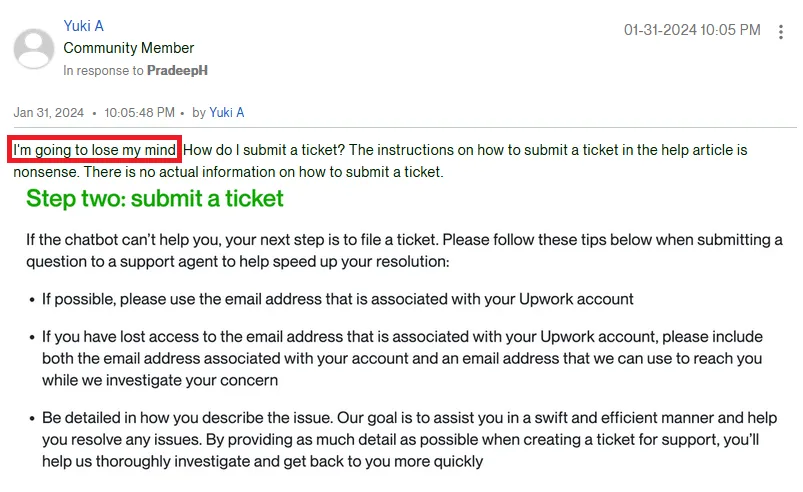What’s more frustrating that a robot that cannot answer your question, is looping constantly over the same FAQs links, and is gatekeeping you from talking to an actual human, that could probably fix your problem in 20 seconds?

The picture above is from Upwork support forum. The thread starts about the customer complaining about the chatbot going in loops. The responses from CS are copypasta with no care about the user’s issue. After a lot of back-and-forth, it took the support 2 weeks to fix an issue that could have been handled in 15 minutes. Don’t be like that.
The symptom
The typical reason for implementing a chatbot for customer service is that it is treated as a cost center, when it is actually a value-making department (it improves LTV, thus augmenting your CAC to LTV ratio -> more value for the same cost).
For example, I keep my home insurance contract because the customer service of my insurance company is so great. I never looked at any competitors prices because of that. I even moved my car insurance contract to them even if it didn’t make sense cost-wise. I just know that I’ll have a great service with them.
What to do instead
Instead of using AI as a first-line barrier, it can be repositioned as a support system that enhances the capabilities of human agents. Here’s how AI can positively impact customer service productivity without replacing the human touch:
-
Use an AI Agent on the customer service representative side, not the client side. AI can quickly go through data to provide CS representatives with relevant information, so they help address customer needs more effectively on complex problems. This will also remove issues of AI Chatbots going wild in front of customers, with all the legal issues it brings.
-
By gathering and analysing data on past interactions, you will slowly build a knowledge base of FAQs. Gen AI can help you build it. Display that on your website, while making sure the UX is good enough. Monitor the amount of calls made for problems that are already registered in the FAQs, as this is a good indicator that your FAQs UX is not good enough.
-
If you really want to use a chatbot, make sure it is only for initial screening, and redirect to human agent as soon as it figures it is not capable of answering.
-
Setting follow-ups after resolving a customer’s issue. AI can craft custom follow-ups to make sure their exact problem is fixed. Good opportunity to do some upsells, and can nearly be fully automated.
AI should help, not hinder. Train representatives to use AI effectively. Always allow customers to reach a human if needed.
So, instead of using a chatbot to reduce the number of calls to your customer services, thus justifying decisions to cut costs, use AI to support human agents, not replace them.
Let’s do an experiment
If you’re not convinced, let’s go for a more pragmatic approach.
To understand the impact of using chatbots versus human agents in customer service, let’s consider an experiment conducted over a year with a company that has 100,000 customers.
Setup
- Group A (50,000 customers): Access to support only through a chatbot.
- Group B (50,000 customers): Direct access to human customer service representatives, augmented with AI support tools.
Results
Churn Rates:
- Group A (Chatbot-only): Churn rate of 20%.
- Group B (Human Support): Churn rate of 12%.
Customer Lifetime Value (LTV):
Average LTV per customer: $1,200.
Customer Service Costs:
- Chatbot System:
- Implementation, maintenance and run: $600,000 per year.
- Human Support with AI Assistance:
- For 3 contacts per customer per year, with an average 10 minutes for each interaction, 20 to 40 agents required.
- Salaries and training for agents: $1,400,000 per year.
- AI tools and software: $300,000 per year.
- Total Cost: $1,700,000 per year.
Financial Impact
-
Group A (Chatbot-only):
- Customers lost due to churn: 20% of 50,000 = 10,000 customers.
- Revenue lost from churn: 10,000 customers × $1,200 = $12,000,000.
- Net cost (Customer service cost + Lost revenue): $600,000 + $12,000,000 = $12,600,000.
-
Group B (Human Support):
- Customers lost due to churn: 12% of 50,000 = 6,000 customers.
- Revenue lost from churn: 6,000 customers × $1,200 = $7,200,000.
- Net cost (Customer service cost + Lost revenue): $1,700,000 + $7,200,000 = $8,900,000.
Analysis
- Human support reduced churn by 40% compared to chatbot-only support.
- Cost-benefit:
- Human support is $1,100,000 more expensive than chatbot support.
- Human support saved $4,800,000 in revenue by retaining more customers.
- Revenue Saved - Additional Cost = $4,800,000 - $1,100,000 = $3,700,000 in favor of human support.
Conclusion
Investing in human customer service, especially when enhanced with AI tools, not only improves customer satisfaction but also has a significant positive impact on the bottom line. The additional cost of human agents is more than offset by the revenue retained through reduced churn. This experiment underscores the value of maintaining a human touch in customer interactions while using AI to empower, not replace, your support team.
👉 Contact me if you want to talk about how you could save time and effort, while improving the quality of your output, using data and AI.
 Valérian de Thézan de Gaussan
Valérian de Thézan de Gaussan